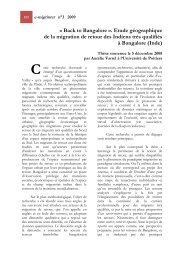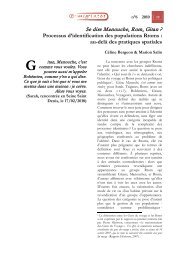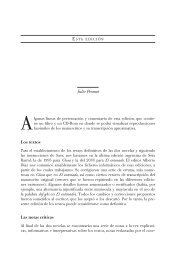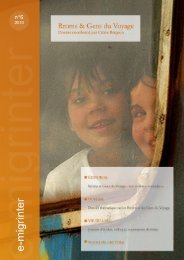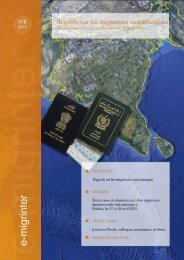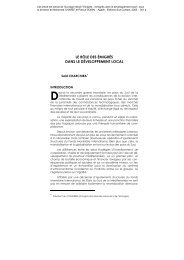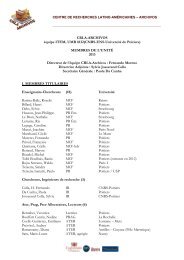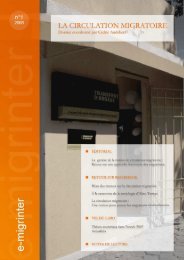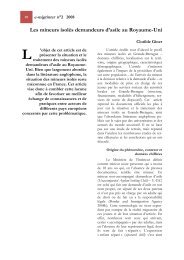e-migrinter 2010 numéro 05 - Maison des Sciences de l'Homme et ...
e-migrinter 2010 numéro 05 - Maison des Sciences de l'Homme et ...
e-migrinter 2010 numéro 05 - Maison des Sciences de l'Homme et ...
You also want an ePaper? Increase the reach of your titles
YUMPU automatically turns print PDFs into web optimized ePapers that Google loves.
n°5 <strong>2010</strong> 63<br />
agree: Being an outsi<strong>de</strong>r both in one’s own work<br />
community and in soci<strong>et</strong>y is formed from many<br />
factors, but from the perspective of the individual it is<br />
clearly a factor which disconnects or even pushes from<br />
the region. High quality of living environment or<br />
saf<strong>et</strong>y will not be sufficient to keep skilled migrants<br />
in Finland if other factors are not right (20<strong>05</strong>:23).<br />
Living environment<br />
Lastly, the importance of living<br />
environment is another factor that has<br />
started to attract attention. Kepsu and<br />
Vaattovaara’s (2008) report for the ACRE<br />
project states that ‘soft’ location factors,<br />
which inclu<strong>de</strong> cultural and leisure amenities,<br />
people’s attitu<strong><strong>de</strong>s</strong>, as well as availability of<br />
open green spaces, should be paid more<br />
attention to (as opposed to only the ‘hard’<br />
location factors of salary, transportation and<br />
public services). Kepsu and Vaattovaara<br />
follow economic geographer Richard<br />
Florida’s claim that companies will follow<br />
where the right workers are available<br />
(Florida 2002; Florida and Tinagli, 2004).<br />
This would imply that employees do not<br />
solely migrate where the work is, rather the<br />
work will be available where they are already<br />
willing to migrate to. Therefore, for<br />
<strong>de</strong>velopment of urban policies attention<br />
should be paid to the movement patterns of<br />
people rather than firms, as their<br />
consequential relationship may be opposite<br />
to that assumed. Kepsu and Vaattovaara<br />
interviewed national migrants moving within<br />
Finland working in the creative and<br />
knowledge intensive industries. In these<br />
interviews, soft factors consistently ranked<br />
among top four important factors when<br />
consi<strong>de</strong>ring where to live. Especially<br />
diversity of leisure and entertainment<br />
opportunities was seen as important.<br />
Raunio’s research shows that among<br />
the skilled migrants in Finland many of these<br />
soft factors received low satisfaction ratings.<br />
Around half of the respon<strong>de</strong>nts felt that<br />
their home region did not offer enough<br />
cultural activities and night life, and that<br />
people were not open and approachable 12 .<br />
However, the importance of cultural services<br />
and night life were most often not consi<strong>de</strong>red<br />
as ‘very important’ nor even ‘quite<br />
important’ factors in the choice of place to<br />
live (Raunio and Sotarauta, 20<strong>05</strong>:20).<br />
Therefore, contrary to Kepsu and<br />
Vaattovaara’s hypothesis, it could be<br />
assumed that most of the skilled migrants<br />
who do <strong>de</strong>ci<strong>de</strong> to come to Finland are not<br />
too concerned about soft location factors in<br />
any case. Perhaps those who want a big<br />
global city with active cultural and night lives<br />
leave Finland out of their field of choices<br />
altog<strong>et</strong>her. Kepsu and Vaattovaara’s ACRE<br />
study is continuing with results from<br />
interviews with transnational workers (i.e.<br />
skilled migrants). Hopefully it will offer<br />
more data for future discussion 13 .<br />
Linking research to policy<br />
The reviewed studies show that<br />
Finland is largely seen as a transitional place.<br />
Skilled migrants move here because of<br />
interesting and challenging work<br />
opportunities that will further their careers,<br />
and are therefore willing to put up with low<br />
wages and high taxes. However, lack of<br />
social contacts (nee<strong>de</strong>d both for career<br />
advancement and social life), limited or no<br />
knowledge of language, difficulty in<br />
un<strong>de</strong>rstanding Finnish mo<strong><strong>de</strong>s</strong> of<br />
communication, and lack of cultural and<br />
social activities are all reasons that push<br />
skilled migrants to leave Finland. Many see<br />
no factors other than their work that would<br />
commit them to stay. All in all, it seems that<br />
12 The cultural activities of my home region are<br />
sufficient (58.2% ‘strongly’ or ‘mostly agree’); Night<br />
life in my home region is lively enough (55%)(Raunio<br />
and Sotarauta, 20<strong>05</strong>:19, figure 5); The atmosphere of<br />
my current home region is open and people<br />
approachable (49.2%); I have enough friends or/and<br />
a well functioning social n<strong>et</strong>work in my current home<br />
region (61.5%); The atmosphere of my current home<br />
region is international (53%) (ibid:22, figure 6).<br />
13 Note: since the writing of this article the results of<br />
Kepsu and Vaattovaara’s interviews with<br />
transnational migrants in Helsinki have been<br />
published (see References: Kepsu <strong>et</strong> al, 2009).



